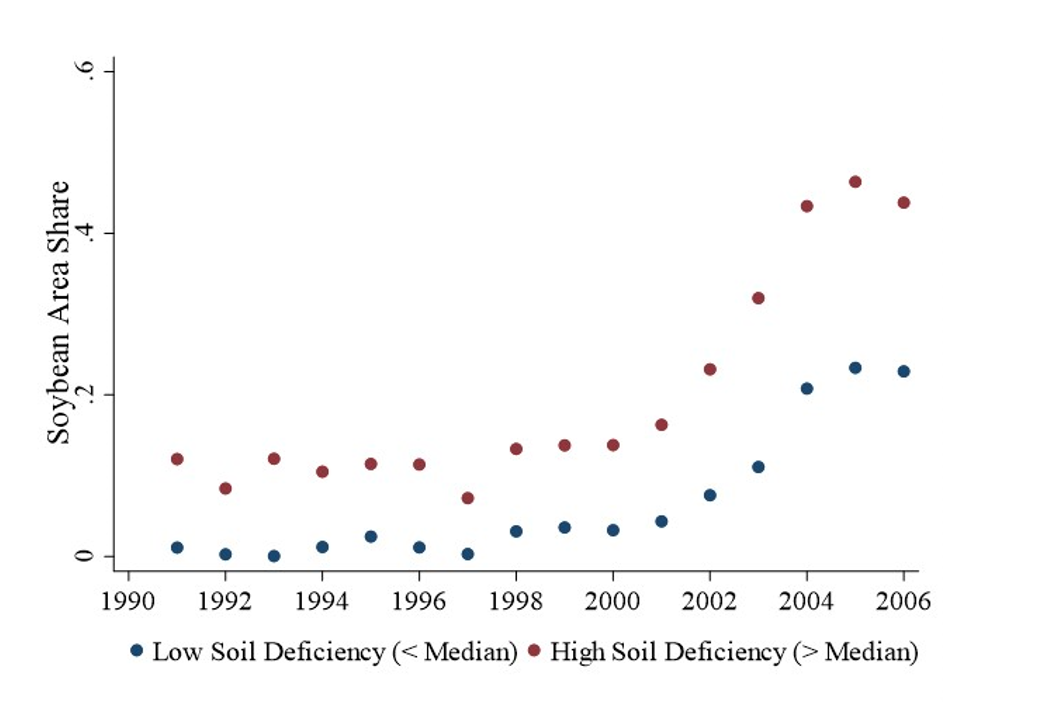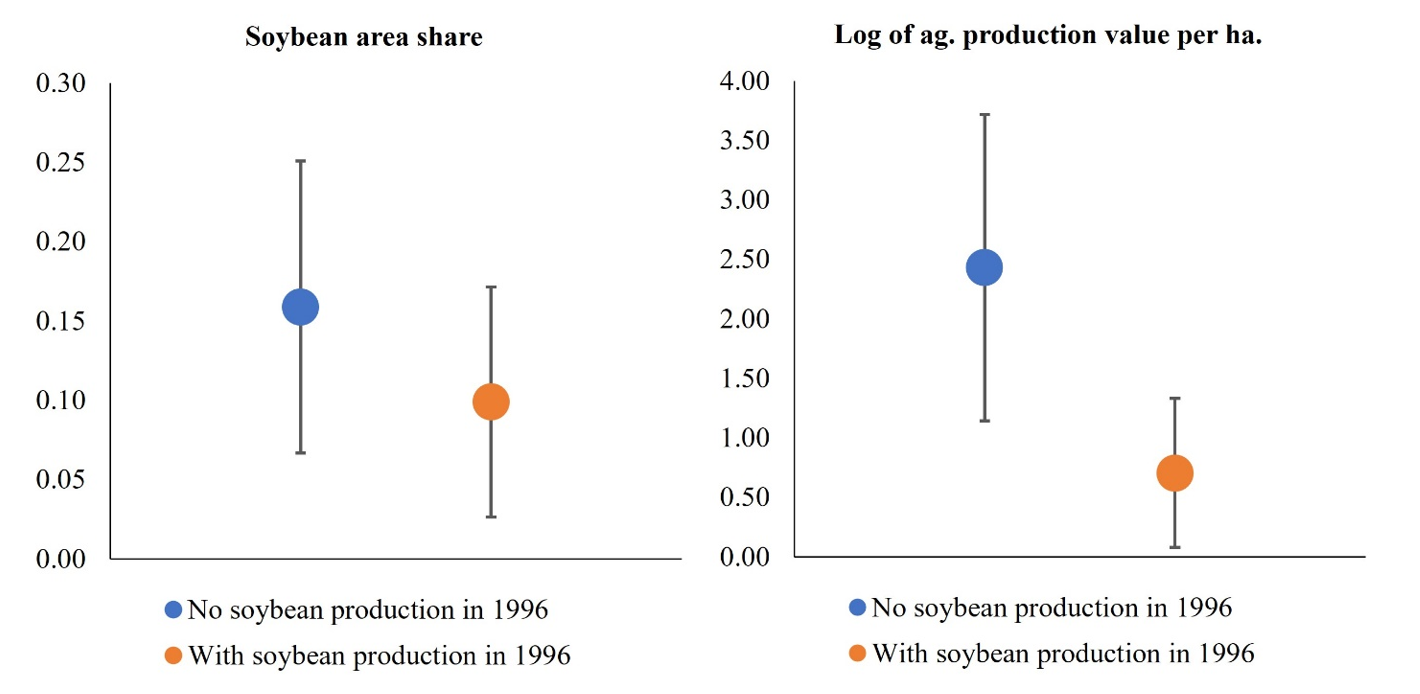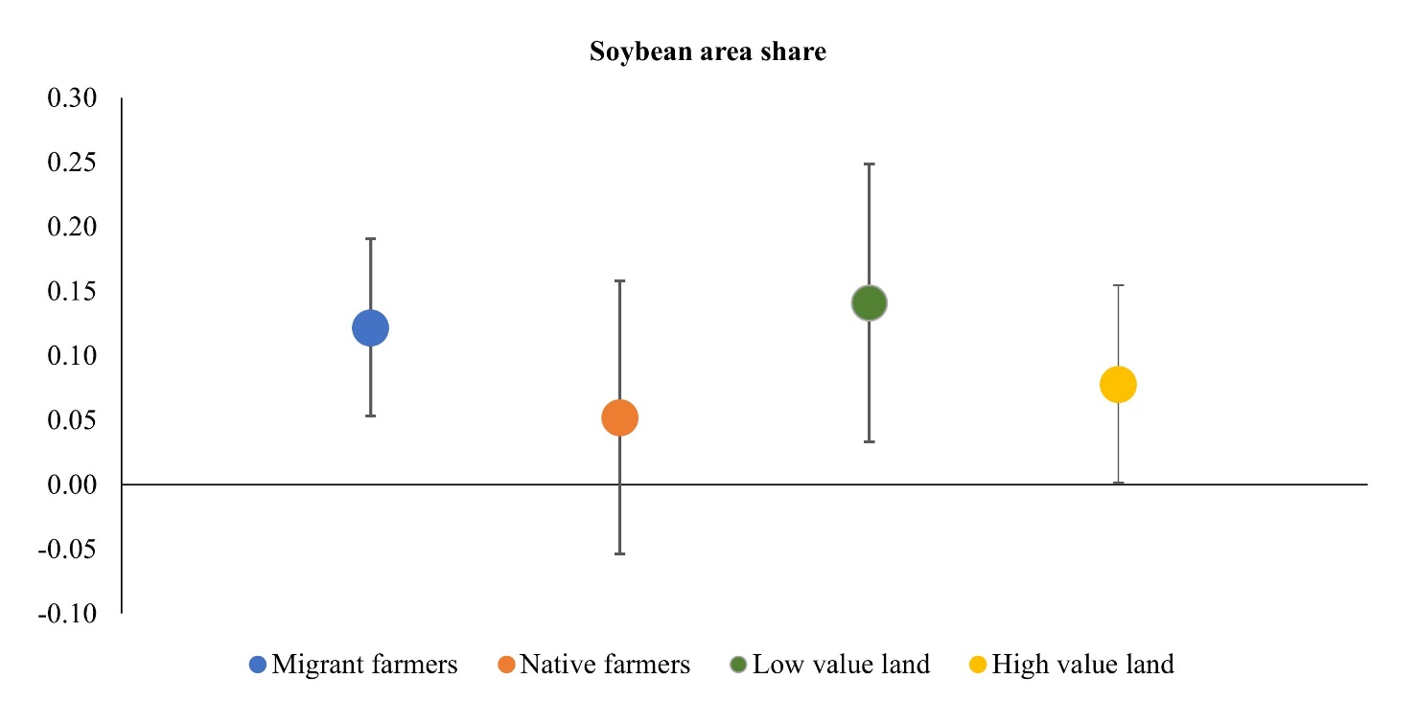
Bundling technology and services enabled the soybean boom in the Brazilian savanna - migrant farmers in low-quality land gained the most from bundled contracting
In many low-income settings, limited access to credit markets, input and output markets, and technical assistance constrains technological innovation and economic growth (Foster and Rosenzweig 2010, Feder and Umali 1993, Feder et al. 1985). My research explores the introduction of a private, bundled contract (linking technology, credit, and access to both input and output markets) to address the multiple barriers to technological diffusion in a low-income region, the Brazilian Savanna (DePaula 2023). I demonstrate that a contractual innovation was at the heart of the “Miracle of the Cerrado”, the remarkable transformation of the Brazilian Savanna into a major global source of soybeans.
The “Miracle of the Cerrado”
The Brazilian Savanna was a region of cattle ranches considered to be unsuitable for agriculture because of its acidic coarse soils and tropical climate. In the 1960s and 1970s, scientists from the Brazilian Agricultural Research Company (EMBRAPA) created the BNF soybean, an ingenious combination of bacteria and soybean varieties designed for the climate and soil in the Savanna (Dobereiner and Pedrosa 1987, 1997, Hungria et al. 2001, Alves et al. 2003).
The efforts of EMBRAPA fueled an initial expansion of soybeans in the Savanna from the 1970s to 1996. However, this BNF soybean expansion only accelerated after a series of macroeconomic reforms in the mid-1990s opened the Brazilian market to international traders. In this second wave of expansion from 1996 to 2006, the soybean area in the Savanna increased by 8.5 million hectares (an area the size of South Carolina). The Economist labeled this rapid increase in production as “The Miracle of the Cerrado”.
The bundled contract
After the economic reforms, a group of large international traders, known in Brazil as the ABCD group (Archer Daniels Midland, Bunge, Cargill, and Louis Dreyfus), invested in fertiliser and soybean-processing companies in Brazil by using a vertical integration business strategy (Junior 2011, Souza 2007). To establish long-term relationships with farmers, the ABCD group offered a package of services that included financing, price guarantees, technical assistance, and inputs for production. The trader–farmer contract is an agreement made before planting starts, committing the farmer to supplying a specific quantity of soybean at harvest for a fixed price in exchange for inputs and financial resources to cover their production costs. This agreement includes technical assistance and a “technological package” of seeds, fertilisers, and pesticides in many cases produced by the trading companies.
The Brazilian agricultural census farm-level dataset
To measure the impact of bundled contracts on soybean production and agricultural productivity, I first constructed a novel panel dataset of farmers’ contracting choices and agricultural outcomes. This combined farm-level data for 1.5 million farmers from two years of the agricultural census (1996 and 2006), the timeframe that spans the fastest period of soybean expansion in the Brazilian Savanna (IBGE 1996, 2006).
Another central problem in the empirical analysis of contracting effects is selection bias. Farmers self-select into contracts based on their own estimated gains, which are unobserved by the econometrician (Bellemare and Bloem 2018). To establish causality, I use variation in the soil chemical deficiency to identify the effect of the bundled contract on agricultural outcomes. Soil deficiency affects contract profitability by increasing the value of bundling technology, technical assistance, and inputs, whereas it does not affect agricultural productivity once the soil chemical deficiency is corrected. In essence, this econometric model approximates an experiment offering a bundled contract to two similar farms with the same potential soybean productivity but with different soil deficiencies. The variation in soil deficiency for similar farms identifies the effect of bundled contracting because farmers who are burdened by the complexity and cost of soil management are more likely to profit from a contract that bundles inputs and services. However, once the soil is corrected farming outcomes are similar for the two farms in the experiment.
Soybean expansion in farmland with soil deficiency
Figure 1 shows the change in the share of farmland allocated to soybean production in the Savanna. The soybean area share in the Savanna was steady during the 1990s in locations with both high and low soil deficiency. However, after the market reforms, soybeans expanded more in locations with low soil deficiency. The relational nature of the bundled contract induced a differential profitability of contracting in the Savanna as the total gain of a bundled contract increases with the complexity of managing the soil. The contracting effect thus captures this additional agricultural expansion into areas that are not farmable without the bundled technology and services and cannot rely on governmental programmes.
Figure 1: Change in the share of farmland allocated to soybean production

Note: Graph 1 plots the time series of the soybean area share in the Savanna by the level of soil deficiency for all municipalities in the Savanna that produced soybean in 2006.
Bundled contracts increase the area of soybean production and agricultural productivity, particularly in places that did not produce soybeans before
Figure 2 plots estimates of the contracting effect on soybean expansion and on agricultural productivity (DePaula 2023). Soybean expansion is measured as the change in the soybean area share and agricultural productivity as the log of the value of agricultural production per hectare. Estimates are shown for the agricultural frontier, census blocks that did not have soybeans production in 1996, and also for blocks with soybean production in 1996.
Figure 2: The contracting effect on soybean expansion and agricultural productivity

Bundled contracting affected the soybean expansion and agricultural productivity in the Savanna markedly, especially in the frontier locations that did not produce soybeans.
Contracting increases the share of soybean area by 15.9 percentage points or 87% of the total soybean expansion in the frontier, compared to 9.9 percentage points or 43% of total expansion in census blocks already producing soybean in 1996. Bundled contracts contributed to a 0.7 log points increase in agricultural productivity in the locations that already produced soybeans in 1996 (doubling productivity). The effect was much larger in census blocks that did not produce soybeans in 1996. In these frontier blocks, bundled contracting increased agricultural productivity by 2.4 log points, a ten-fold increase.
Migrant farmers and farmers in marginal land gained more from bundled contracts
Figure 3 plots the contracting effects on soybean expansion for four subsamples: migrants, native famers, low value land, and high value land - the place of birth of the farmer reported in the agricultural census is used to divide the dataset into subsamples of migrant and native farmers. I also divide the sample into locations below and above the median agricultural production value per hectare in 1985, 10 years before the period of analysis.
Figure 3: The contracting effect on soybean expansion for migrants and for marginal land

For migrant farmers, the contracting effect on the soybean area share is 0.122, twice that for native farmers. I also find that the contracting effect on soybean expansion is twice as large on land with historically low agricultural productivity. On low-productivity land, the contribution of contracting to soybean expansion and agricultural productivity is 83% and 75%, respectively. On high-productivity land, contracting contributes 55% of the soybean expansion and has no effect on agricultural productivity.
These results are consistent with the theoretical prediction of larger contracting surpluses on low-productivity land with multiple development constraints. Savanna soybean farmers heavily burdened by the complexity and cost of soil management were more likely to profit from a contract that bundled inputs and services. The most productive farmers, who were more capitalised and had better market access and higher quality land, generated more profits on their own.
Key takeaways for policymakers
First, in the Brazilian case, the technological diffusion only took off after all the market failures were addressed. Policies addressing individual market failures separately may not succeed in such environments. Secondly, the private sector can play a central role on the diffusion process as traders and migrant farmers were key agents in the transformation of the Savanna. Restrictions on trade and migration could therefore impede the technology adoption process. Third, scale matters. A technological solution must substantially increase production as well as the agricultural economic surplus, and the region must be sufficiently large to justify a multinational firm’s substantial investment. Finally, economic institutions such as private property rights must be sufficiently secure to ensure returns on investment. These conditions depend on government policies.
References
Alves, B J, R M Boddey, and S Urquiaga (2003), "The success of BNF in soybean in Brazil," Plant and Soil, 252(1): 1–9.
Bellemare, M F and J R Bloem (2018), "Does contract farming improve welfare? A review," World Development, 112: 259–271.
DePaula, G (2023), "Bundled contracts and technological diffusion: Evidence from the Brazilian soybean boom," Journal of Development Economics, 165: 103163.
Dobereiner, J (1997), "Biological nitrogen fixation in the tropics: Social and economic contributions," Soil Biology and Biochemistry, 29(5-6): 771–774.
Feder, G, R E Just, and D Zilberman (1985), "Adoption of agricultural innovations in developing countries: A survey," Economic Development and Cultural Change, 33(2): 255–298.
Feder, G and D L Umali (1993), "The adoption of agricultural innovations: A review," Technological Forecasting and Social Change, 43(3-4): 215–239.
Foster, A D and M R Rosenzweig (1996), "Technical change and human-capital returns and investments: Evidence from the green revolution," American Economic Review: 931–953.
Hungria, M, R J Campo, and I C Mendes (2001), "Fixação biológica do nitrogênio na cultura da soja," Embrapa Soja-Circular Técnica (INFOTECA-E).
IBGE (1996), "Censo agropecuário - ano 1995/1996," Instituto Brasileiro de Geografia e Estatística (IBGE), Confidential data accessed at Centro de Documentação e Disseminação de Informações (CDDI), Rio de Janeiro, Brazil.
IBGE (2006), "Censo agropecuário - ano 2006," Instituto Brasileiro de Geografia e Estatística (IBGE), Confidential data accessed at Centro de Documentação e Disseminação de Informações (CDDI), Rio de Janeiro, Brazil.
Junior, V J W (2011), "Dinâmicas e estratégias das agroindústrias de soja no Brasil," volume 4, Editora E-papers.
Souza, J F D d (2007), "Integração vertical e financeirização: O caso da agroindústria processadora de grãos no Brasil," PhD thesis, Universidade de São Paulo.

